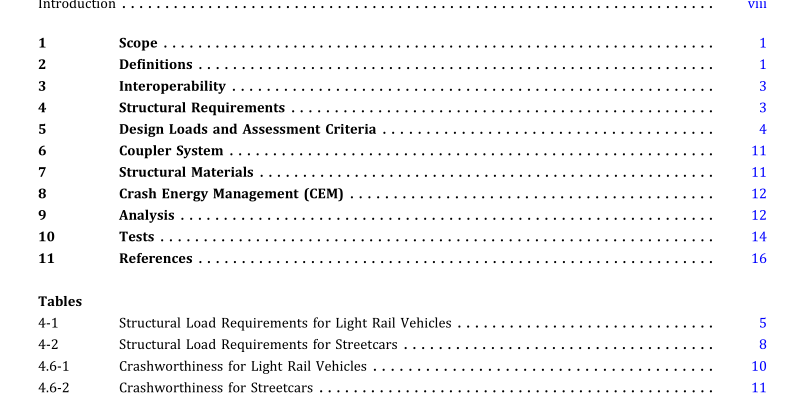ASME RT-1-2020 pdf free download.Safety Standard for Structural Requirements for Light Rail Vehicles and Streetcars
1.1 Subjects Not Addressed by This Standard
There are several design considerations issues related to safety that are not addressed in this Standard, such as the following:, but not limited to
(a) structural repairs
(b) fatigue
(c) corrosion
(d) fire protection
(e) interior vehicle design
(f) emergency egress from vehicle
(g) inspection and maintenance
(h) operator seat belt
1.2 Effective Date
This Standard applies to carbodies of newly constructed light rail vehicles and streetcars for transit passenger service ordered 180 days following the date of issuance of this Standard that is issued by the Rail Transit Vehicle (RTV) RT Standards Committee and ASME.
2 DEFINITIONS
This Standard relies, where practical, on terms already in use by ASME, the American Public Transportation Association (APTA), and the Institute of Electrical and Electronics Engineers (IEEE). For the purposes of this Standard, the following definitions apply: anticlimber: a structural member or mechanism located at each end of the vehicle, used to engage an opposing vehicle, car or other coupled or not, vehicle to resist relative vertical travel between the two carbodies during a collision.
belt rail: a longitudinal structural member of the carbody located on each side of the carbody below the passenger side windows. The distance between opposite belt rails rail often establishes the overall width of the carbody, exclusive of the side door thresholds, and the side cameras, and mirrors.
car-module: a fully assembled vehicle section that spans between couplers, articulating joints, or a coupler and an articulation. A module may be supported by a truck or may be suspended between two articulations without a truck.
collision posts: a set of two structural posts located at each end of the carbody, extending from the bottom of the underframe structure up to the structural shelf. Collision posts may can be made of several structural members assembled to each other, provided that the required performance is met. They are located at the approximate one-third points across the width of the vehicle, and are forward of the seating position of any passenger or crew person. An alternative to collision posts is the use of a collision wall. collision wall: a structure at the leading end of the vehicle spanning the area between the structural shelf, corner posts, and top of the underframe.
corner posts: a set of two full-height structural posts located at or near the two corners at one end of the carbody, extending from the bottom of the underframe structure up to the roof structure. Corner posts can be an assembly of several structural members assembled to each other provided that the required performance is met
coupler system: a system that comprises comprised of the coupler head, drawbar, draft gear, and attachments to the carbody, permitting the connection between light rail vehicles or streetcars. The coupler system may be permanently extended in position, or of the folding/retractable type often stored behind a bumper system.
light rail vehicle (LRV): vehicle that operates LRVs operate on a light rail transit system, and is are not part of mainline railroads. Light rail vehicles are capable of boarding and discharging passengers at track/street level or elevated curbs and platforms.
The light rail vehicle is a mode of rail transit characterized by its ability to operate on exclusive rights-of-way, shared street running, and through roadway grade crossings. (see also streetcar). occupied volume: the volume of the light rail vehicle or streetcar where passengers or crewmembers are normally located during service operation, such as the operating cab and passenger seating and standing areas.
The entire width of a vehicle’s end compartment that contains a control stand is an occupied volume. An articulation or gangway is typically not considered occupied unless there are seats. override: the behavior of end-to-end colliding vehicles such that one vehicle vertically rides above the other resulting in unintended crush deformations. Overriding can lead to telescoping intrusion of car-modules.ASME RT-1 pdf download.ASME RT-1-2020 pdf free download
